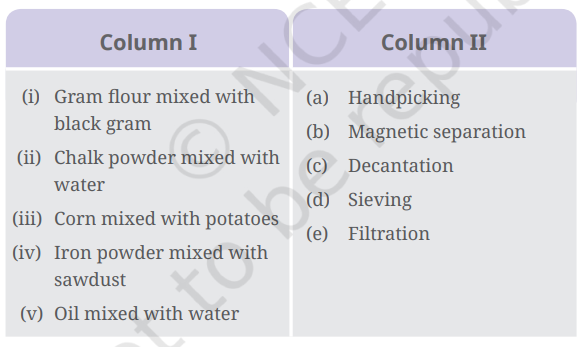Methods of Separation in Everyday Life
Question 1. What purpose does handpicking serve in the process of separation?
(i) Filtration
(ii) Sorting
(iii) Evaporation
(iv) Decantation
Answer:
(ii) Sorting
Question 2. Which of the following substances are commonly separated using the churning method?
(i) Oil from water
(ii) Sand from water
(iii) Cream from milk
(iv) Oxygen from air
Answer:
(iii) Cream from milk
Question 3. Which factor is usually essential for the filtration?
(i) Apparatus size
(ii) Presence of air
(iii) Pore size
(iv) Temperature of the mixture
Answer:
(iii) Pore size
Question 4.
State with reason(s) whether the following statements are True [T] or False [F]. Also, correct the False statements).
(i) Salt can be separated from ‘ salt solution by keeping it under the Sun.
Answer: True
Reason : This process is called evaporation, where the water evaporates, leaving the salt behind.
(ii) Handpicking should be used only when the quantity of one component is less.
Answer: True
Reason: Handpicking is useful when the unwanted component is less and can be easily picked by hand.
(iii) A mixture of puffed rice and rice grains can be separated by threshing.
Answer: False
Correct statement: Threshing is used to separate grains from stalks, not for separating puffed rice from rice grains. The correct method here would be winnowing.
(iv) A mixture of mustard oil and lemon water can be separated by decantation.
Answer: True
Reason: Since oil and water do not mix, decantation can be used to separate them
(v) Sieving is used to separate a mixture of rice flour and water.
Answer: False
Correct Statement: Sieving is used for separating solids based on particle size, but it can’t separate flour from water. Filtration would be more appropriate.
Question 5. Match the mixtures in Column I with their method of separation in Column II.
Answer:
| Column I | Column II |
| (i) Gram flour mixed with black gram | (d) Sieving |
| (ii) Chalk powder mixed with water | (e) Filtration |
| (iii) Corn mixed with potatoes | (a) Handpicking |
| (iv) Iron powder mixed with sawdust | (b) Magnetic separation |
| (v) Oil mixed with water. | (c) Decantation |
6. In what situations would you use decantation instead of filtration to separate solids from liquids?
Answer: Decantation is used when the solid particles are large or have settled at the bottom. It is useful when filtration is not needed for very fine particles, such as separating sand from water.
7. Can you relate the presence of nasal hair to any separation process?
Answer: Nasal hair acts like a filter, similar to filtration. It traps dust and other particles from the air we breathe, preventing them from entering the lungs
8. During the COVID-19 pandemic, all of us wore masks. Generally, what material are they made of? What is the role of these masks?
Answer: Masks are generally made of materials like cotton, synthetic fibers, or polypropylene. Their role is to filter out airborne particles, including viruses and bacteria, to prevent their inhalation and spread.
9. A mixture containing potatoes, salt and sawdust has been given to you. Outline a stepwise procedure for separating each component from this mixture.
Answer:
Step 1: Handpick the large potato pieces from the mixture (handpicking).
Step 2: Add water to the remaining mixture. Salt will dissolve, and sawdust will float.
Step 3: Skim off the sawdust (decantation).
Step 4: Boil the water to evaporate and recover the salt (evaporation)
10. Read the following story titled ‘Intelligent Leela’ and tick the most appropriate options. Protnde a suitable title of your choice for the paragraph.
Leela was working in the farm with her father when she realised that they left their drinking water at home. Before her father felt thirsty/hungry, she went to the nearby pond to fetch some water/ grains. After obtaining some water in the container, she noticed that the water was muddy and fit/unfit for drinking. To purify the water, she kept it for some time and then she filtered/churned the muddy water using a piece of paper/ muslin cloth. Leela, then, cooled/ boiled the water for about 10 minutes in a covered pan. After cooling/boiling, she filtered/churned it again and made it fit/unfit for drinking. She served this water to her father while having food, who blessed her and appreciated her efforts.
Answer:
A possible title could be “Leela’s Clever Solution for Clean Water”. The story shows how Leela used sedimentation, filtration, and boiling to make muddy water safe to drink

Very nice
Very nice